Companies have always been in constant change. Be it in terms of technology or organization. Now that agile methods have found their way into companies, the credo is now to synchronize various agile and classic methods and to break up classic hierarchies in order to make your own organization faster and more flexible.
One approach to this can be the Spotify model, which has been gaining more and more importance since 2014. But German companies are characterized by special processes and a long tradition – in contrast to Spotify, which started out on the greenfield.
So is it possible to just copy the Spotify model? Certainly not! In this article, I would like to show my experience in introducing and adapting the Spotify model for a fictional German company and underpin it with my experience of the last 2 years from my professional experience with the Spotify model. For general information about the Spotify model, you can consider my reading tip, as I assume in this article that you are roughly familiar with the model.
Reading tip: Spotify model
The classic hierarchy: controllability and control
In most companies we find what is known as a classic hierarchy, i.e. the division of work into small units with a focus on specialization. This is often reflected in the organizational chart and is visible in departments and teams.
For example, a webshop department can be divided into the SEO, content marketing, purchasing and order processing teams. At the top sits a department head who receives information through a meeting with the board of directors and various management meetings and passes this on to the employees via the team leader. Information and escalations from day-to-day business are escalated to the department head via the team leader.
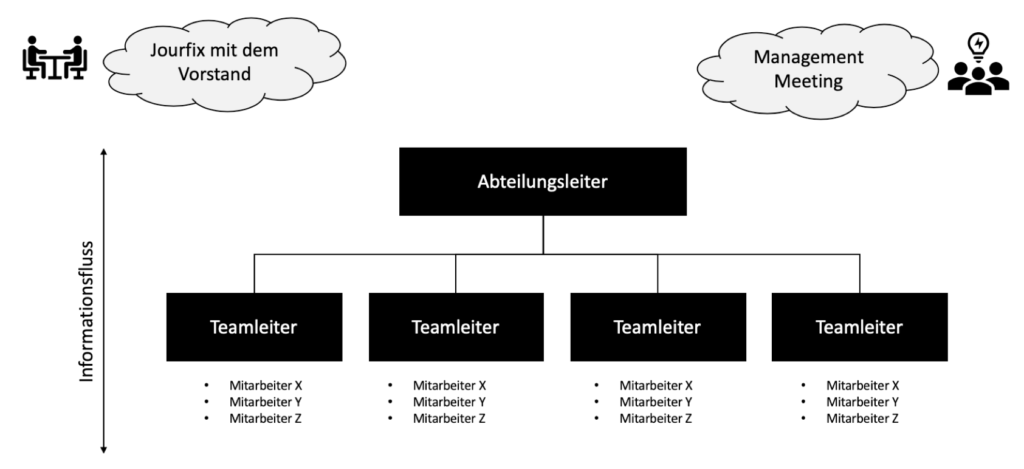
This type of organization is very stable, plannable and optimized for manageability and control. The disadvantages lie in coping with complexity and speed due to the lack of flexibility and the pressure from employees to organize themselves as well as problems in the compatibility with agile methods. The possible consequences are customer and employee dissatisfaction.
Customer dissatisfaction due to slow processes
One consequence of optimizing manageability and control is the structure of the teams and departments. The following scenarios are sure to sound familiar to you:
- Tasks that are defined by processes are solved quickly
- Tasks that several teams need or are neither in the area of one nor the other team often remain lying around for months.
If you have a specific question, you will hear sentences like: This is not my area, I am not responsible for this and there is no process for this. The team leaders are also primarily concerned with their own area. This is constantly being strengthened, protected and expanded. The consequence is strong silos.
Employee dissatisfaction due to a lack of perspective
Has a service provider ever resigned from you? This can be painful for companies. A Study by LinkedIn asked more than 10,000 employees about their reasons for changing jobs. More than 45% indicated a lack of perspective in the company.
A career in the classic hierarchy is often difficult. Employees have to wait for a position to become vacant and responsibility can often only be assumed as a team or department leader. As an employee, you get your clearly defined area of responsibility.
Jourfixes and meetings with other managers and board members, i.e. information, are a strong instrument of power. The meetings mentioned appear to normal employees like clouds, which are visible but inaccessible to you. Those who sit in this meeting or manage to be invited will soon be able to count themselves among the narrow circle of leadership.
The boss has more experience, more information and more power than his employees. The employees are therefore more dependent on their boss than, conversely, the boss on them.
Dr. Marcus Raitner
From the classic hierarchy to the Spotify model
A radical shift towards frameworks like Scrum of Scrums or LeSS is often neither useful nor does it really help companies. I therefore recommend breaking down the hierarchy slowly and constructively and increasing the satisfaction of customers and employees.
Reading tip: Agile framework from my doctoral thesis
One way to make an organization fit for digital change is to adopt some ideas from the Spotify model and adapt them to your own company. I recommend following four steps.
Reading tip: Change management according to Kotter
Step 1: Division of the department into squads and change of leadership
In the first step, we look at which focus points the department has and divide the employees into powerful and cross-functional groups (squads) with a size of 3-8. Cross-functional means that a squad can solve tasks without many interfaces.
The important thing is that you can cut your squads quickly and well. Many companies are obviously having a hard time doing this. Spotify itself has made the division according to functions on the website. Further possibilities would be divisions according to:
- Industries (e.g. with service providers)
- Customers (e.g. with IT service providers)
- Products (e.g. at product house)
- Functions or technology (e.g. at a software company)
- Divisions (e.g. in corporations)
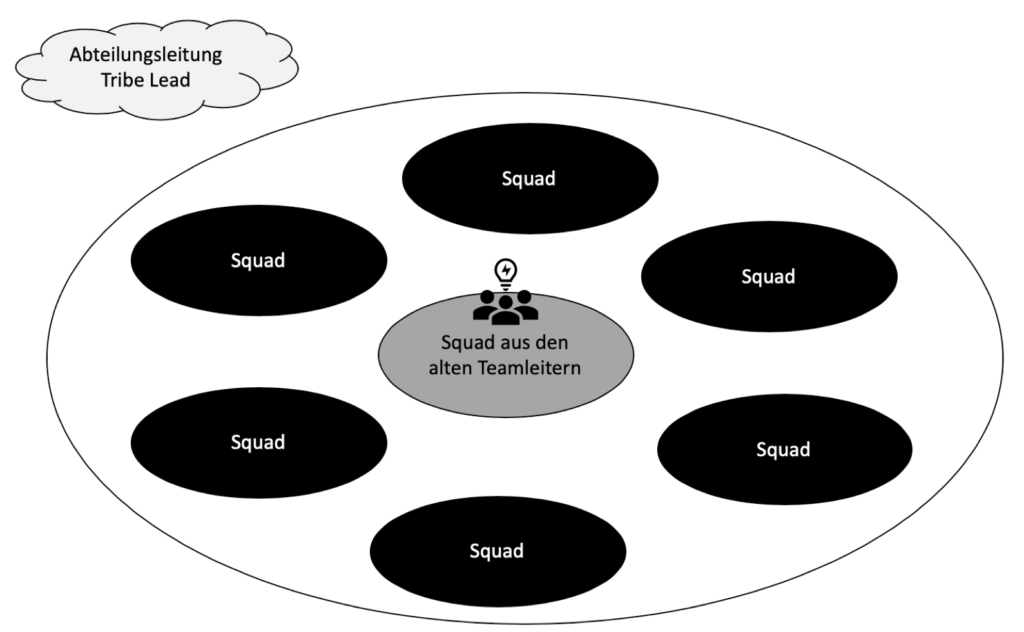
It is important that a holistic view emerges. If a customer’s order in the web shop was previously processed by 3 teams, this should now be reduced to one team. The advantage is a holistic view of the process by the squad. Sentences like: I am not responsible for this or I have no authorization for that will be a thing of the past.
What do you do now with the team leaders? Leadership is still important, but it should no longer be tied to one person. My recommendation is: form a squad from the executives who is the global contact for all squads and who takes care of the management tasks.
I can tell you from my own experience that as a manager in the classic sense you are often alone. The Harvard Business Review magazine conducted a survey of numerous executives. Almost half of all CEOs feel lonely and this can have a negative impact on their performance. The consequence is a lack of feedback and difficult self-reflection. The fact that you bring the managers together to form their own team also promotes their performance.
Something is also changing for the head of department. He keeps the view from the outside and acts as a coach and organizational developer. Due to the fact that the leadership quad can take over all operational tasks of leadership, the time is there for it.
In summary, you divide the department into powerful units with an eye for the whole and minimize interfaces for a holistic view of the process. Leadership is also represented by a powerful unit. The advantages lie in the even distribution of managers. Rather rational managers can help with customer escalations and emotional managers with conflicts. The management quad is basically (theoretically) the perfect manager with the best cast.
My learning: Leadership is not a privilege but a service and hard work!
Step 2: Creation of cross-sectional roles and appointment of the squadleads
Now it is time to organize the individual squads and connect them to one another. First of all, each squad appoints a squadlead who represents the squad externally. The team leaders also appoint a squadlead of the command quad. You now have the following organization.
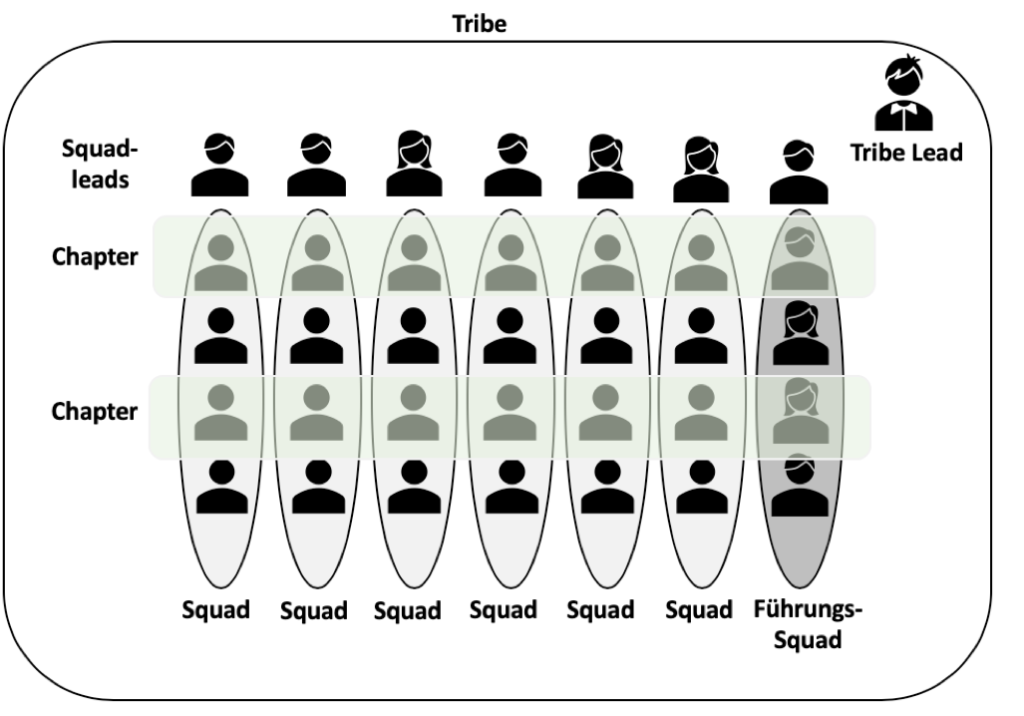
In the illustration you can also see chapters which are marked green. In order to promote professional exchange, we form cross-section chapters, i.e. specialist groups that deal with a topic. In contrast to classic cross-sectional roles (toothless tigers), the chapters form a high committee for your purpose and monitor, for example, the use of a technology and the compliance with uniform standards, e.g. for databases or software code. With a strong division according to functions, a chapter can also be a process (order process) or, for customers, a technology (Java).
Incidentally, the chapters represent a bit of the horizontal specialist career and the squads the vertical leadership career. By changing Sqaud and the new roles, you offer employees a permanent perspective and the opportunity to create their own job ( Jobcrafting ).
Spotify also suggests guilds, but I’ve never found a sensible use case for this, and in my professional life I’m currently completely satisfied with squads and chapters. Guilds are usually there to train each other and exchange knowledge. Often these are the internal user groups. But you have no influence in the decision-making process.
My learning: The job of leadership is no longer to approve vacations and manage the team, but rather like a gardener who tends a greenhouse.
Step 3: Adapt meetings and information flow
What would knowledge work be without data and information? Not much! That is why the new organization also needs new information channels. For a very long time I thought about the number and type of meetings, because meetings are expensive and employees can be boring. You can find my ideas in the following illustration.
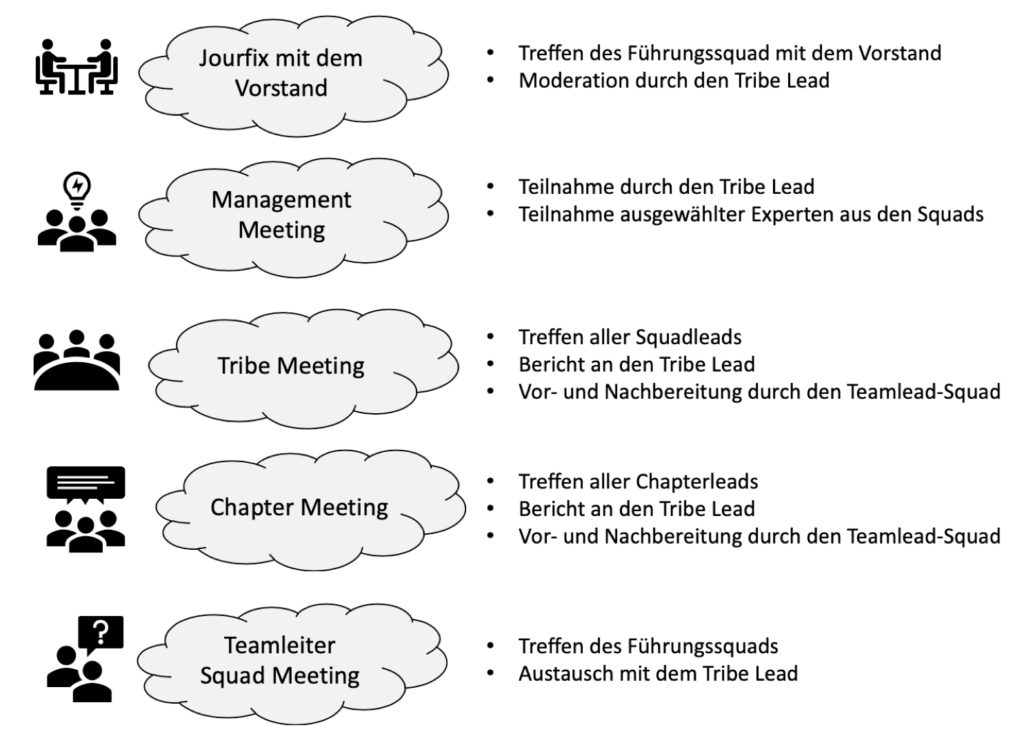
I recommend expanding the meeting with the board to include the squad that is taking the lead. The tribe lead moderates the topics and shows the board of directors: my department is not just about one hero but about many great and motivated employees.
I have not yet adapted the classic management meeting with other departments, as acceptance in the entire company must first exist.
Furthermore, it has been shown that a meeting of all squad leads and all chapter leads once a month makes sense, as well as a meeting between the tribe lead and the leadership quad once a week.
I think the formats shown make sense, as information is now distributed horizontally and no longer individual persons have too much information sovereignty and everyone can contribute to the department.
My learning: The leadership in such a system is now similar to the relationship between conductor and musician in an orchestra.
Step 4: Adjust controlling and maintain controllability
Of course, an organization must also be visualized using certain instruments. I took this step 1 year after the start of the change. I have implemented two controlling instruments for this purpose.
Hard controlling: business indicators
I come from the IT service industry. We work on an hourly or fixed price basis for numerous customers and issue an invoice. If you only have internal customers, then just ignore the time booking part.

Each squad has its own board to visualize their work. How the squad arranges the board is individual. It is only important that it is clear:
- What do you want to do this week?
- What are you working on right now?
- What have you done?
There are numerous free software such as Redmine but also paid software such as Jira for implementation. Each task has an agent and a customer / project assigned. In this way, expenses per customer, squad and project can be viewed. I have created an individual dashboard on it.
It is important that you teach the squadleads how the software is used and how to work correctly according to Scrum or Kanban. We are only able to provide information to the board of directors and customers if all fields are correctly filled out. I carried out internal training and individual coaching and founded a chapter.
Since we as a service provider always need proof of work and have to issue an invoice to the customer, each employee adds the corresponding time to a tool after completing a task. In addition to the number of the task, it also indicates the hours. In this case, it is not of interest how long the employee works in total, only:
- How many hours have created value for the customer?
- what do we have for the customer?
My learning: With the help of tough controlling, the squads can work autonomously and flexibly in terms of location and time.
Soft controlling
Peter Drucker said: “culture eats strategy for breakfast” and in this model it is especially important to monitor the culture. My experience is that the organization is incredibly flexible and fast, but also very sensitive.
First of all, I conducted a workshop with each squad and recorded values, vision and guidelines. So it falls to the squads to continue to lead themselves.
Reading tip: Team workshop slides
To then measure the soft factors, there is the Spotify Squad Healthcheck . They use various criteria to check the satisfaction of the individual squads every 14 days. The squad leads use traffic light colors to convey the mood in the squad to you. In the following you will find my traffic light maps.
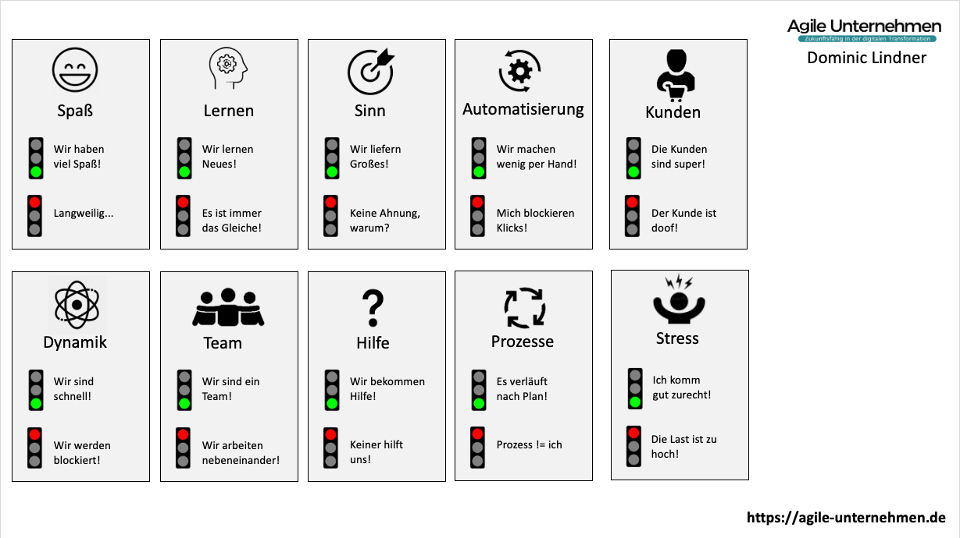
Tip: Download the template like here and adjust them!
The individual results are very useful for the squad leads. It is now up to the Tribe Lead to pack all results into a uniform table. It looks like the following figure.

In the columns you can see the main differences between the different squads. Squad 2 is happy with pretty much everything. Squad 3 has many problems, but there is a positive trend on almost all points.
In the Rows we can recognize systemic patterns. Every squad has fun at work (and the trend is even higher!). Motivation doesn’t seem to be a problem. However, the processes cause problems. Over time, this will certainly reduce the fun factor at work.
in the Overall picture you can see that many arrows are pointing up. This means that the improvement process (the most important process of all) is working.
My learning: This type of organization can only function on values and trust. This has to be measured regularly!
Conclusion
The Spotify model is a great source of inspiration for an agile organization. Of course, every company has special framework conditions that do not allow the model to be simply copied. However, it makes sense to take some basic ideas from them and adapt them to your own organization. I particularly like the division of leadership into a central squad and the new transparency of information. I hope that the impulses of my article can help you in your daily work. I can tell from my own experience that such a change can be mastered in 1 year and can significantly increase the satisfaction of employees and customers.
Reading tip: Agility in service companies
Reading tip: Agility in product houses
Image source: Music photo created by freepik – www.freepik.com
[werbung] [fotolia]


